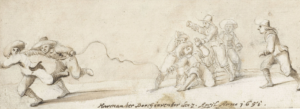Tug of Peace.
Marc Jacobs
Since 2001 I have been involved and engaged in the making of global tools for safeguarding intangible cultural heritage. Today many of those instruments are presented (and updated every two years) by UNESCO as a set of so-called Basic Texts, either in printed form (thanks to some consistency in choosing a dark or light blue cover, nicknamed the Blue Book) or electronically in Portable Document Format. Co-creating them was a collective process in many meetings under the UNESCO flag in which thousands of individuals were participating, or just co-present, in the course of the 21st Century. In order to structure this global quest in many arenas, nameplates of national states that are members of the UNESCO are used to arrange seats and access to microphones, next to the nameplates for the Secretariat, for roles in the meeting format (like chairperson, rapporteur, …) for NGOs and other observers, etc. I had the chance over more than two decades to be part of teams and delegations behind the nameplate “Belgium”.
I saw a few dozens of people showing up at these meetings for longer periods of time (some veterans also already 22 years) but also many hundreds of people participating once or a few times, during their diplomatic tour of duty in UNESCO for a few years or as silent eye-witnesses-for-a-week. It is interesting to see how this complex changing and volatile population of people made, and make, the UNESCO Convention of the Safeguarding of Intangible Cultural Heritage and interlocking instruments. The group dynamics is fascinating and usually, but not always, functions to keep some balance and consistency, as long as the rules of the game of consensus building are more or less respected.
If you try to decode and find patterns in all the processes in the whirlpool, some metaphors can be handy, like for instance “tug of war”. The image above shows how this game was represented in the Netherlands in 1651 (https://www.rijksmuseum.nl/nl/collectie/RP-T-1887-A-906), but variations were found far away and long before, and after. It is funny to know that before the expression “tug of war” was introduced in the 19th century in the English-speaking world, such rope pulling was sometimes called French and English, now the two working languages in UNESCO. But it actually existed much longer and in many regions of the world, beyond the colonial empires that offered their working languages. Items like the tugging rituals in the Republic of Korea, Viet Nam, Cambodia and the Philippines, were inscribed in 2015 (10.COM) on the Representative List: “Most variations include two teams, each of which pulls one end of a rope attempting to tug it from the other. The intentionally non competitive nature of the event removes the emphasis on winning or losing, affirming that these traditions are performed to promote the well-being of the community, and reminding members of the importance of cooperation”. (https://ich.unesco.org/en/RL/tugging-rituals-and-games-01080) To win or to win-win?
You can use the metaphor of tug of war to refer to episodes in the UNESCO expert meetings and in the Organs of the convention, the General Assembly or the Intergovernmental Committee. Think about all those painful episodes of inscribing elements on the aforementioned List, trying to pull imperfect nomination files from rejection or referral to inscription. Or about the discussions about those criteria. Or about how strictly to respect them. The elephant in the room, the construct of outstanding universal value or the world heritage list, is often influencing those incidents. Recurrent tug of war about what counts as equitable distribution of inscriptions or of NGOs. Or about the wording of texts. And many other issues that were on the menu…
In the beginning of the 21st century, some of these debates were about the relation between intangible cultural heritage and (over)tourism, (over)commercialization, (over)simplification, (over)exploitation and other possibilities of (over)instrumentalization, that may have detrimental effects on viability, ownership or control. Or about inflation effects, Wikipedia or other participatory platforms, the need for follow-up and other forms of housekeeping of the lists. In order to achieve consensus, first about the wording and articles of the convention and then later about the operational directives, some tug of war discussions were suspended. They were put “in the fridge”. Ten years after the launch of the 2003 Convention and five years after the first batch of the operational directives, the process of trying to deal with these issues gradually came on the agenda. Also issues of climate change, connected to the concept of sustainable development were occasionally (often lukewarm) topics of the COM-discussions. “Transforming our world: the Agenda 2030 for sustainable development” was appropriated as a frame, although it did not yet grant culture and heritage a fair chance (yet). This was partly framed and canalised in a new set of operational directives, packaged as the Sixth Chapter of that Basic Text.
The invitation for the Intergovernmental Committee that is held in Africa in 2023 is worthy of a twentieth birthday of a Convention with a growing toolbox of interlocking instruments. Just like in 2008 or 2015, the agenda of the Intergovernmental Committee in 2023 has potential to be a gamechanger (but wait and see). For the first time in the history of Committee meetings, all nomination files (agenda items 8a, 8b and 8c) presented for discussion and decision in the 18th meeting of the Intergovernmental Committee were accompanied by an advice of the Evaluation Body to inscribe on the Representative List, the List of Intangible Cultural Heritage in Need of Urgent Safeguarding and to include in the Register of Good Safeguarding Practices. So, all the usual diplomatic tug of war scenes (and loss of precious quality time) to try and overcome a less favourable evaluation, might not be necessary in that meeting in Botswana. So there is a chance that other, bigger issues might get more attention, including the challenges that have long been avoided and postponed – in the fridge – to later: understand now. Under item 12 “thematic initiatives on living heritage and sustainable development” an interesting text actually attempts to address the issues of (i) the economic dimensions of safeguarding intangible cultural heritage, (ii) safeguarding intangible cultural heritage and climate change, and (iii) the safeguarding of intangible cultural heritage in urban contexts. Under item 11 a very promising reflection on a broader implementation of Article 18 of the Convention and a proposal for related amendments to the Operational Directives are scheduled. It connects with the Overall Results Framework, one of the change management tools that is part of the Basic Texts since 2018, and that is used as a canvas for subsequent clusters of periodic reports. In the 18COM-meeting experiences from the group of the so-called “Arab States” are shared. It also contains a surprising extra point 7.c. on the Agenda, which makes an active link with one of the major challenges of this decade, the Agenda 2030 and what will be a follow-up of that transformational agenda. The 2023 agenda of 18COM about old and new agendas and many other topics can be optimistically regarded as a fruitful combination and opportunity to set levers in motion to better use toolboxes of the 2003 Convention. As long as even seasoned participants occasionally experience expectations for improvement and impact, there is hope.
It is necessary to draw attention to an instrument in the Blue Book, the Ethical Principles for Safeguarding Intangible Cultural Heritage. The tool is not perfect and not easy to understand and even more difficult to apply. Some of the principles are very radical and even impossible to realise if you take them seriously. Just read ethical principle 9 and realise what is demanded: “(9) Communities, groups, local, national and transnational organisations and individuals should carefully assess the direct and indirect, short-term and long-term, potential and definitive impact of any action that may affect the viability of intangible cultural heritage or the communities who practise it.” But the Ethical Principles manage to reveal the contradictory Siamese twin-Spirit of the Convention, captured in other words. At the request of UNESCO, in 2016, I worked on a set of capacity-building tools to introduce and explain the ethical principles. As happens more often than you think, also that set of deliverables never got published and was buried in the archives. I did learn a lot from this exercise, including how the tug of war metaphor can be used to understand what is going on in that specific Basic Text. On the one hand there is a set of principles emphasising the relative autonomy of/respect for communities, groups and individuals that are the core of the “heritage community”/network in which the intangible cultural heritage functions. On the other hand, there are the global wake-up calls and cosmopolitical sensitivities, programs, and aspirations (as exemplified in the SDGs of the Agenda 2030) of and for humanity. Up to a point they are both “the right thing to do”, so tug! The dozen Ethical Principles are an interesting sensitising tool, “a set of overarching aspirational principles” (…) to serve as a basis for the development of specific codes of ethics and tools adapted to local and sectoral conditions.”, as the Basic Text spells out. But what is forgotten or not yet activated are other fragments of the decision 10.COM 15.A in 2015: “7. Requests the Secretariat to develop an online platform with a toolkit based on the ethical principles (…) 8. Invites accredited non-governmental organisations to participate in enriching, sharing information, following-up, and contributing to update the online platform with tools of ethics for safeguarding intangible cultural heritage”. In 18.COM a new attempt will be made, in agenda point 8 about empowering article 18, to propose online tools to make a change. It is about caring, connecting and linking, win-win rather than just winning and losing.
Another sub point on the 2023 agenda, 7c, can open one of the most interesting trajectories in years, although not without risk. I am referring to the attempt of following-up on the bold Mondiacult 2022 strategic endeavour, to try and influence the Agenda beyond 2030 and to make sure that culture is not pushed away again as it was in 2015 when the SDGs were made. The stakes but also the price are high, by already reorienting the mechanism for periodic reporting and its connection with a methodology of change (see the Overall Results Framework) towards a joint reporting from different heritage conventions. It is a fascinating but risky plan; how can the (cultural) world avoid ending up again with something like the not so clever, discriminating Sustainable Development Goal Indicator 11.4.1. Can this be done in a reasonable and caring way, dealing with a potential tug of war with the “outstanding universal” (pulling) power of what the 1972 UNESCO Convention turned out to be, a reduction against which the 2003 Convention was created as a cure in the first place. So, we need something else. In her book Because We Can Change the World, Maria Sapon-Shevin proposed the metaphor of a Tug of Peace, also playfully cultivated in a cooperative game (see https://cooperativegames.com/fun-free/tug-of-peace/). Perhaps it is a possibility to actually try to mobilise power and strength within UNESCO by going for a tug of peace this time, including not only the different heritage conventions and the 2005 UNESCO Convention, but also for instance the 2015 recommendation on museums or the recommendation in the same year about memory institutions (and the Memory of the World Program). It can demonstrate the power of caring and/for heritage or trying to do the right things, while dealing with the tensions which were captured by the Ethical Principles of the 2003 Convention. Yes, ‘You may say I’m a dreamer. But I’m not the only one. I hope someday you’ll join us’. Why not on a useful e-platform or by daring and sharing a good safeguarding practice?
Download: Marc Jacobs – Belgium.pdf


